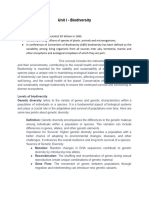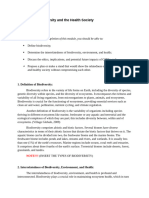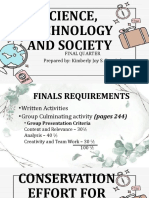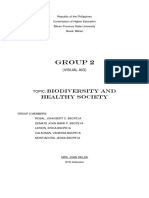Theme Biodiversity: Conservation and Agricultural Sustenance
Theme Biodiversity: Conservation and Agricultural Sustenance
Uploaded by
Paeng RafaelCopyright:
Available Formats
Theme Biodiversity: Conservation and Agricultural Sustenance
Theme Biodiversity: Conservation and Agricultural Sustenance
Uploaded by
Paeng RafaelOriginal Description:
Original Title
Copyright
Available Formats
Share this document
Did you find this document useful?
Is this content inappropriate?
Copyright:
Available Formats
Theme Biodiversity: Conservation and Agricultural Sustenance
Theme Biodiversity: Conservation and Agricultural Sustenance
Uploaded by
Paeng RafaelCopyright:
Available Formats
Theme Biodiversity: Conservation and Agricultural Sustenance
Biodiversity (or biological diversity) refers to variability of living organisms of terrestrial, marine and other aquatic ecosystems. Entire aspect of biodiversity can be grouped in three categories i.e, Genetic Diversity (variations of genes within the organisms of a species), Species Diversity (variation of species within a region) and Ecosystem Diversity (variation in the form of vegetation and other wild life in a broad ecosystem). Human has always been the greatest beneficiary of the biodiversity as it provides food, medicines and industrial products. It is estimated that the total number of species variety of different living forms are around 10 millions. Out of such an enormous number, only 1.5 millions have been identified so far. Such a variety of living organisms is important from the point of view of sustenance of life forms on earth. All these varieties of various life forms have coevolved over the period of time since the origin of life on earth. The variety of different species, their habitats and ecosystem help maintaining a balance of life forms as well as resources on earth. A drastic change in the habitat or ecosystem leads to depletion in the variety of species and also extinction. Thus protection and conservation of biodiversity is not only important from the point of view of fulfillment of our need, rather it is equally or even more important for the very survival of human and other living organisms on the earth. Also, we need to understand the concept of a strong, safe and secure nation. For this, we must not forget the aspects of a healthy, productive and safe environment besides food, education, economy and national security. The exhibits/ models on this sub-theme may pertain to: Exhibits showing the methods of measurement of biodiversity; Models showing the significance and importance of the biodiversity; Strategy for ecological restoration of the micro and macro habitat; Impact of climate change on biodiversity and their remedial measures; Impact Assessment study of various developmental activities on biodiversity; Strategy/ methods for the presentation and protection of threatened / rare/ endangered plants and / or animals; Assessment of the impact of various human activities on the biodiversity of a region; Identification of plants of medicinal value in the biodiversity rich area; Report of already known medicinal plants from a new area; Impact of monoculture in forest during afforestation and reforestation; Studies on the impact of introduction of exotic species in a natural ecosystem; Causes and impact of deforestation due to various river valley projects; Causes and impact on biodiversity rich hilly region due to construction of large dams; Causes and impact of deforestation due to various industrial activities; Inventorisation of biological resources in different regions/ parts of the country; Strategy for sustainable use of genetic resources / germ plasm; Reclamation of wasteland and revival of their biological potential through microorganism conservation; Understanding of the intricate relationships and linkages between plants and
animal species in an ecosystem; Role of biological sciences including biotechnology in multiplication of the rare, endangered and endemic species; Strategies for in situ conservation of wild life by multiplication and restoration of threatened, rare and endangered species; etc.
You might also like
- Biodiversity and The Healthy Society HO 1Document6 pagesBiodiversity and The Healthy Society HO 1Johoney MarceloNo ratings yet
- BiodiversityDocument22 pagesBiodiversityGurmeet SinghNo ratings yet
- EnviSci Lesson 6 BiodiversityDocument27 pagesEnviSci Lesson 6 BiodiversityJohn Carlo De Guzman OcampoNo ratings yet
- Biodiversity Chapter 1 - 2Document52 pagesBiodiversity Chapter 1 - 2Essays EsayasNo ratings yet
- NarrativereportDocument57 pagesNarrativereportSean Carlo LopezNo ratings yet
- Biodiversity and ConservationDocument6 pagesBiodiversity and Conservationrakesh.lilasiNo ratings yet
- Unit I Biodiversity Notes - 1Document23 pagesUnit I Biodiversity Notes - 1Durga DamleNo ratings yet
- Biodiversity ConservationDocument15 pagesBiodiversity ConservationArun B VijayNo ratings yet
- Exploring BiodiversityDocument2 pagesExploring Biodiversityvoidmagic200No ratings yet
- Importance of BiodiversityDocument53 pagesImportance of BiodiversitypaulangelomicoNo ratings yet
- The Significance of Biodiversity in EcosystemsDocument2 pagesThe Significance of Biodiversity in EcosystemsKelvin de WaeleNo ratings yet
- Environmental Science AssignmentDocument8 pagesEnvironmental Science AssignmentsambitNo ratings yet
- Untitled DocumentDocument14 pagesUntitled DocumentGaurav GNo ratings yet
- (GED109) Chapter 8 Biodiversity and Healthy SocietyDocument59 pages(GED109) Chapter 8 Biodiversity and Healthy Societypreclipse789123No ratings yet
- STS Final Lesson 3Document22 pagesSTS Final Lesson 3Danica VillarNo ratings yet
- Week10_Biodiversity and the Health SocietyDocument34 pagesWeek10_Biodiversity and the Health Societydarish joy moralesNo ratings yet
- BIODIVERSITY AND ITS CONSERVATIONDocument23 pagesBIODIVERSITY AND ITS CONSERVATIONshinnosukenoharahNo ratings yet
- Biodiversity and conservation (1)Document6 pagesBiodiversity and conservation (1)4L Anisha SieudassNo ratings yet
- Resume pdf-14Document1 pageResume pdf-14ittosaachiNo ratings yet
- EnviSci 4thDocument104 pagesEnviSci 4thJucel BroñolaNo ratings yet
- Transpareny 3Document6 pagesTranspareny 3nitesh tirkeyNo ratings yet
- Lecture 5 Environmental ScienceDocument22 pagesLecture 5 Environmental Scienceebrahim.ahmed.fayezNo ratings yet
- KavinDocument12 pagesKavinsharveshsampathNo ratings yet
- BiodiversityDocument3 pagesBiodiversityLawrence ZviksNo ratings yet
- Biodiversity and health soceityDocument2 pagesBiodiversity and health soceitykrisha BattungNo ratings yet
- Biodiversity - Species, Genetics & Ecosystem Biodiversity (Upsc Notes)Document13 pagesBiodiversity - Species, Genetics & Ecosystem Biodiversity (Upsc Notes)Rohini Sundaram100% (1)
- Meve 14Document9 pagesMeve 14Prime VideoNo ratings yet
- The Significance of Biodiversity ConservationDocument1 pageThe Significance of Biodiversity ConservationbarteksribdNo ratings yet
- Ark Note 2Document18 pagesArk Note 2Nusrat ShoshiNo ratings yet
- Lecture On Biodiversity: Introduction To Environmental ScienceDocument70 pagesLecture On Biodiversity: Introduction To Environmental ScienceJubair Syed100% (1)
- Document (4) 3 EnvDocument4 pagesDocument (4) 3 EnvAdyasha RoutNo ratings yet
- Title - "The Importance of Biodiversity - Exploring Earth's Web of Life"Document1 pageTitle - "The Importance of Biodiversity - Exploring Earth's Web of Life"mfabregamarinNo ratings yet
- What Is Biodiversity?Document2 pagesWhat Is Biodiversity?MichelleneChenTadleNo ratings yet
- W13 Conservation Effort On BiodiversityDocument35 pagesW13 Conservation Effort On BiodiversityKimberly EspañolNo ratings yet
- Conservation of Biodiversity: Tanisha Sarraf 01317001721 Bba Shift 1 Environmental StudiesDocument20 pagesConservation of Biodiversity: Tanisha Sarraf 01317001721 Bba Shift 1 Environmental StudiesTanisha SarafNo ratings yet
- Introduction To BiodiversityDocument8 pagesIntroduction To BiodiversityAnnapoorneshwariNo ratings yet
- Biodiversity ...........Document14 pagesBiodiversity ...........Pratiksha JadhavNo ratings yet
- Chapter 16Document6 pagesChapter 16vashuok081No ratings yet
- shiyam 2Document28 pagesshiyam 2felixwagon5No ratings yet
- Science About EnvironmentDocument37 pagesScience About EnvironmentjajacolicoNo ratings yet
- GRP-2 BiodiversityDocument7 pagesGRP-2 BiodiversityRonaly HiladoNo ratings yet
- Module 1 BiodiversityDocument15 pagesModule 1 BiodiversityVidhyashree YadavNo ratings yet
- Unit-15 Biodiversity and Conservation (BOT-503)Document23 pagesUnit-15 Biodiversity and Conservation (BOT-503)saurabhsinghrajput396No ratings yet
- BiodivesityDocument3 pagesBiodivesityanshul0714No ratings yet
- BIORESOURCE notesDocument25 pagesBIORESOURCE notesvaishnavi18162003No ratings yet
- Be A Part of The Plan KAVYA - EditedDocument3 pagesBe A Part of The Plan KAVYA - EditedPiyush GoyalNo ratings yet
- Biodiversity Conservation in IndiaDocument20 pagesBiodiversity Conservation in Indiaadeeba showkatNo ratings yet
- STS Module 12 Biodiversity and The Healthy Society EnhancedDocument44 pagesSTS Module 12 Biodiversity and The Healthy Society EnhancedRyan Fernandez Dela Cruz100% (1)
- Biodivesitate - Articol 2Document3 pagesBiodivesitate - Articol 2sfinx77772496No ratings yet
- Group 2: Biodiversity and Healthy SocietyDocument4 pagesGroup 2: Biodiversity and Healthy SocietyCelia Theresa DelimaNo ratings yet
- Kavin PDFDocument11 pagesKavin PDFsharveshsampathNo ratings yet
- Final Module ActivityDocument16 pagesFinal Module ActivityJoellaNo ratings yet
- C. Biology PascoDocument10 pagesC. Biology PascodelalejusticeNo ratings yet
- BiodiversityDocument42 pagesBiodiversityEnitsuj Eam EugarbalNo ratings yet
- Biodiversity: Made By: Roll No.: ClassDocument19 pagesBiodiversity: Made By: Roll No.: ClassChiranjiv KarkeraNo ratings yet
- Biology YDocument5 pagesBiology YMark BuhainNo ratings yet
- Biodiversity Management in KenyaDocument8 pagesBiodiversity Management in KenyaEICQ/00154/2020 SAMUEL MWANGI RUKWARONo ratings yet
- Group 8 - Biodiversity and The Healthy SocietyDocument10 pagesGroup 8 - Biodiversity and The Healthy SocietyReanne James Sicena QuibralNo ratings yet
- Introduction To BiodiversityDocument10 pagesIntroduction To Biodiversitymundesandeep45No ratings yet
- Biodiversity Finance: Innovative Tools for a Flourishing PlanetFrom EverandBiodiversity Finance: Innovative Tools for a Flourishing PlanetNo ratings yet
- MODULE 7.1-Converted-MergedDocument23 pagesMODULE 7.1-Converted-MergedMerrie Anne BagsicNo ratings yet
- Part-1 MCQsDocument159 pagesPart-1 MCQsirfanullahNo ratings yet
- SAQA - 116169 - Summative Assessment MemorandumDocument38 pagesSAQA - 116169 - Summative Assessment MemorandumkarahmashavaNo ratings yet
- Epidemiology and ZoonosesDocument149 pagesEpidemiology and ZoonosesAbhijith SP100% (1)
- BBA Hons CBCS 2019Document65 pagesBBA Hons CBCS 2019VISHNU OPNo ratings yet
- B Tech - BiotechDocument164 pagesB Tech - BiotechPrashant TripathiNo ratings yet
- Final Exam in ScienceDocument2 pagesFinal Exam in ScienceLyn OlitaNo ratings yet
- Liu Et Al 2015 Systems Integration For Global SustainabilityDocument11 pagesLiu Et Al 2015 Systems Integration For Global SustainabilityjanethsiaoNo ratings yet
- BSC (1) Enviorment SciDocument27 pagesBSC (1) Enviorment ScilpNo ratings yet
- Ecology EssayDocument1 pageEcology EssayYakini GazaEmpress HowellNo ratings yet
- Es036 Obe SyllabusDocument5 pagesEs036 Obe SyllabusNiño Dwayne TuboNo ratings yet
- AgricultureDocument8 pagesAgricultureAna Mae MaitNo ratings yet
- Chapter Vii: The Economics of EcologyDocument11 pagesChapter Vii: The Economics of EcologyMDRRMO BulaNo ratings yet
- Biodiversity in India-ProjectDocument54 pagesBiodiversity in India-ProjectVarun Sawant83% (6)
- Lecture 1-Environmental ToxicoDocument11 pagesLecture 1-Environmental ToxicohenoksolNo ratings yet
- Terrestrial EcosystemDocument27 pagesTerrestrial EcosystemCamille FaustinoNo ratings yet
- 2012 APES Mid-Term Study GuideDocument6 pages2012 APES Mid-Term Study Guideinvisible_winterNo ratings yet
- Pond Ecosystem BodyDocument17 pagesPond Ecosystem BodySourav Kumar Samanta71% (55)
- Pollution CourseworkDocument5 pagesPollution Courseworkbetevopelah3100% (2)
- Course Structure and Syllabus UG - R20: Cse - Artificial Intelligence & Data ScienceDocument40 pagesCourse Structure and Syllabus UG - R20: Cse - Artificial Intelligence & Data ScienceSumanth 7899No ratings yet
- Principles of EcosystemDocument21 pagesPrinciples of EcosystemPrincess Kaye CasuelaNo ratings yet
- BiodiversityDocument94 pagesBiodiversitySaif Mohammad100% (2)
- Boyero Et Al. 2020. Microplastics Impair Amphibian Survival, Body Condition and FunctionDocument7 pagesBoyero Et Al. 2020. Microplastics Impair Amphibian Survival, Body Condition and Functionprevencionista servimanefNo ratings yet
- Brofenbrenner Report 9Document17 pagesBrofenbrenner Report 9Dhazel Joy JanitoNo ratings yet
- TFG Pau Baquin DefinitiuDocument31 pagesTFG Pau Baquin DefinitiuPau BarquinNo ratings yet
- Project IN Science: Don Honorio Ventura State UniversityDocument2 pagesProject IN Science: Don Honorio Ventura State UniversityDenmar GarciaNo ratings yet
- Bio Project 12thDocument28 pagesBio Project 12thƦakeshNo ratings yet
- Environmental Biotechnology For Soil and Wastewater Implications On EcosystemsDocument119 pagesEnvironmental Biotechnology For Soil and Wastewater Implications On EcosystemsGOUTAM DASNo ratings yet
- Environmental Science - CHY1002 Module-1: Environment and EcosystemDocument17 pagesEnvironmental Science - CHY1002 Module-1: Environment and EcosystemermiasNo ratings yet
- Chapter 5 DisturbanceDocument5 pagesChapter 5 DisturbanceJersey Mae PerlasNo ratings yet

























































































